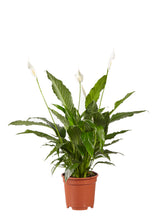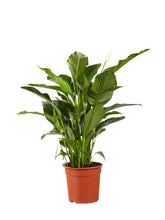Spathiphyllum wallisii are native to Venezuela and Columbia and are part of the Araceae family. They have a very dense full appearance, leaves are held horizontal to the petiole. It’s worth noting that it’s not uncommon for your plant to not produce as many blooms as when you first bought it - often nurseries use gibberellic acid to increase the number of flowers, this is a natural plant hormone that induces flowering.
Genus name comes from the Greek word 'spathe' and 'phyllon' meaning a leaf from the leaflike spathe. Specific epithet is named after Guztav Wallis, a collector in the Andes for the William Bull nursery in Chelsea.
Light: Bright indirect light, meaning the plant sees the sun for 0-4 hours per day - this could be through trees or a translucent curtain, it’s important for the plant to see the sky in order to thrive.
Water: Allow the first 2-3 inches of mix to dry out. Before watering, ensure the substrate isn’t compacted, if it is, aerate it with a few pokes of a skewer or blunt stick, pour water slowly over the top and allow the water to pass through the drainage holes. Spathiphyllum will faint/droop when extremely dry.
Potting mix: A well draining mix composed of coco coir, perlite, orchid bark and worm castings.
Fertilising: Feed your plant every other watering during the growing season or when you observe active growth. You can dilute fertiliser to half the recommended amount but never add more.
Temperature: Ideally 18-28°C.
Humidity: Spathiphyllum would prefer higher humidity. You can increase humidity by placing the plant on a watered pebble tray or using a humidifier.
Spathiphyllum wallisii are toxic, keep out of reach of pets and children.







